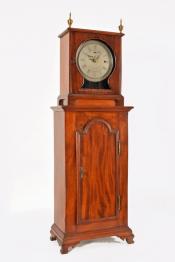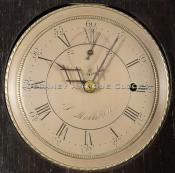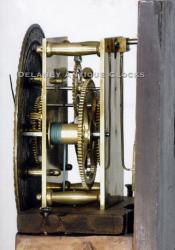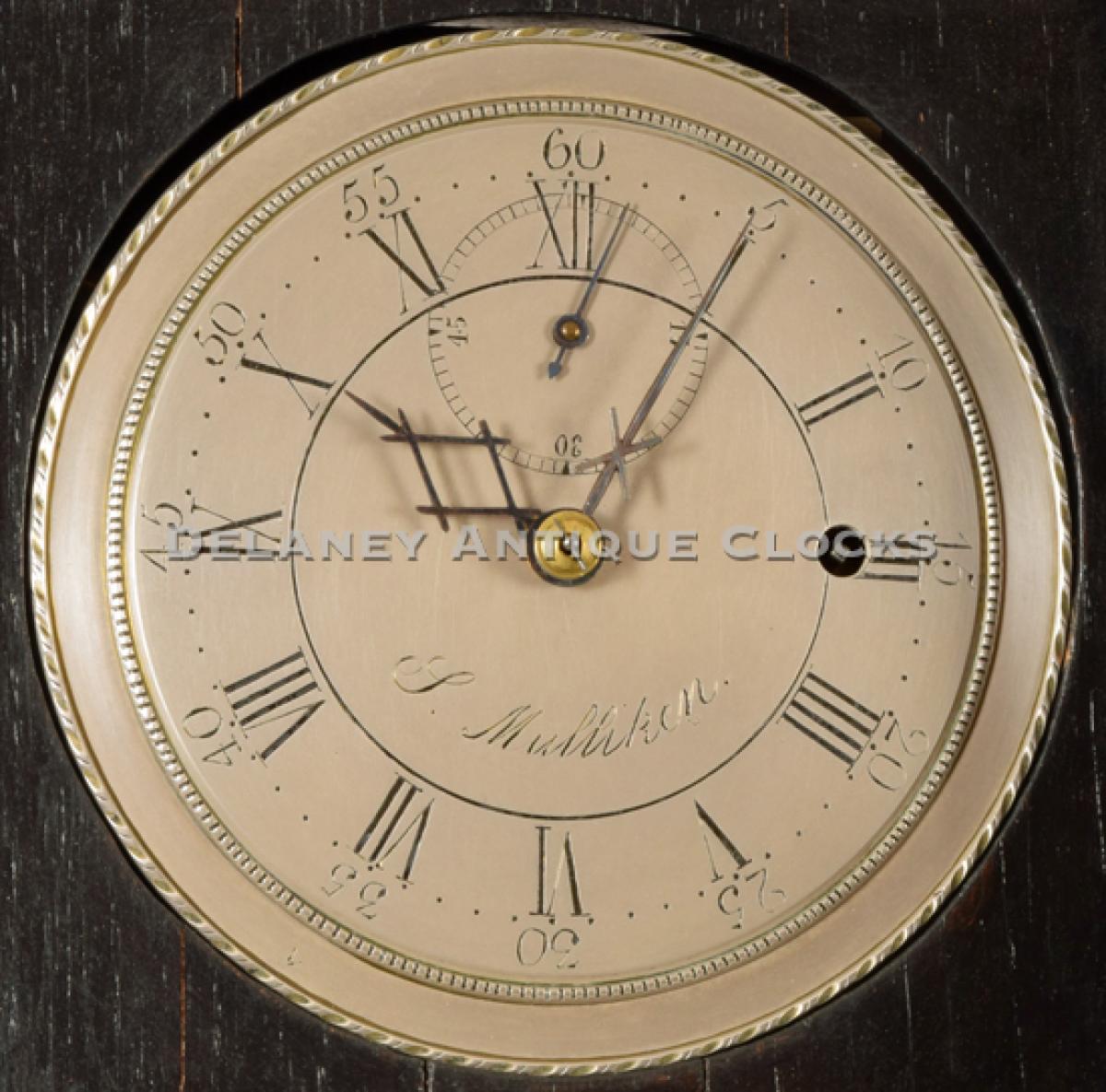Samuel Mulliken (1761-1847) Newburyport. An important Massachusetts shelf clock. LL-73.
This is an important mahogany case-on-case Massachusetts Shelf Clock made by Samuel Mulliken of Newburyport, Massachusetts.
Samuel Mulliken II was born in Haverhill, Massachusetts, the son of John Mulliken and Susanna Huse (1735-1820) on April 9th,1765. He is a member of a very important family of American Clockmakers. It is thought that he was trained by his distant cousin Jonathan Mulliken (1746-1782) of Newburyport. Jonathan died in 1782. Samuel married Jonathan’s widow, Susannah (Pearson) Mulliken, a year later, in 1783. Samuel’s Newburyport clock shop was located on State Street. Here, he developed business ties with the Willards from Roxbury, agreeing to sell Simon’s Patented Clock Jacks. In 1789, Samuel moved from Newburyport to Lynn, Massachusetts, and then the following year to Salem, Massachusetts. In Salem, Samuel advertises himself as a merchant. In 1796, he moved back to Lynn and became the town’s postmaster in 1803. Samuel died in Lynn in 1847. Other examples of brass and white dial shelf clocks are known. One brass dial version is currently in the Peabody Essex Museum Collection in Salem, Massachusetts. A similar example to the Peabody Essex clock is pictured in “The Old Clock Book” written by N. Hudson Moore. It is illustrated between pages 142 and 143 in Black and white. It is figure no. 85. In 1911, it was owned by Mrs. H. P. Brownell of Providence, Rhode Island. It is reported that she owned approximately 50 antique clocks at this time. This is one she admired, and it received special attention.
This is an early example of the Massachusetts shelf clock form. It is often referred to as a “case-on-case” model. The upper section appears to be sitting on the base. This case is constructed in mahogany. The wood selected features a subtle-grained pattern that retains an older surface. The color is pleasing. This case stands up off the self on applied bracket feet that exhibit good form. The base section is long and dominated by a large tombstone-shaped door. The door is trimmed with a molded edge. This is a subtle detail that is, in my opinion, very successful. One can access the painted red tin can weight and pendulum through this doo. The hood or bonnet sits on top of the base section. The top of the case features a large central plinth. This incorporates several piercings that make it visually light and pleasing. Three brass urn finials are mounted at the top of the case. One is positioned at the top of the plinth. The hood door is also a prominent feature and is designed with an arch opening fitted with glass. This hood door is hinged and opens to access the dial. The matt board is painted black. It surrounds the arched dial.
This iron dial is formatted like a tall clock dial of the period. This dial was locally painted by a yet-to-be-identified North Shore, Massachusetts artist. Similar dials have been found on other clocks from his region. The spandrel areas are painted and decorated with floral themes. A view of a small city taken from the outskirts is in view. A river, a classical promenade, an arched bridge, a multistory building, and trees are the prominent features. The time ring is formatted with Roman hour numerals and Arabic five-minute markers. This dial is signed by the Clockmaker in script lettering. The hands are steel and are an excellent form.
This fine movement is constructed in brass and is of good quality. Four ringed turned cigar-shaped pillars support the two brass plates. Hardened steel shafts support the polished steel pinions and brass gearing. The winding drum is not grooved grooved. The escapement is designed as a recoil format. The weight-driven movement is designed to run for approximately 4.5 days on a full wind. This example is a single train design fitted with a fall-off striking arrangement. On each hour, the hammer is lifted and then released to strike once each hour. This clock strikes a cast iron bell that is mounted above the movement on a bell stand that is attached to the backplate.
Inventory number LL-73.
Samuel Mulliken II was born in Haverhill, Massachusetts, the son of mariner John Mulliken, a Captain in the state militia during the American Revolution, and Susanna Huse (1735-1820) on September 22, 1761. He is a member of a very important family of American Clockmakers. Samuel was apprenticed as a clockmaker and an engraver by his distant cousin Jonathan Mulliken (1740-1782) in nearby Newburyport. Samuel may have completed his apprenticeship and worked as a journeyman in Salem, only to return to Newburyport after his uncle Jonathan died in 1782. He likely took over Jonathan's shop and courted his widow, Susannah (Pearson) Mulliken. Samuel and Susannah were married a year later, on August 20, 1783. Samuel's Newburyport shop was located on State Street. Here, he continued manufacturing clocks, engraving clock dials, repairing watches, and doing light metalwork. He also developed a business relationship with the Willards from Roxbury, agreeing to sell Simon's Patented Clock Jacks. Samuel returned to Haverhill and opened his shop in 1787 through October 1788. He lost his wife Susanna in 1787 to yellow fever. By the end of November 1788, Samuel re-established himself in Salem, MA, on the corner of Court Street. He was busy doing various tasks for his cousin through marriage, the Sanderson brothers, Elijah, and Jacob. By March of 1789, Samuel has married his second wife, Sarah Newhall, daughter of Colonel Ezra Newhall. His watch repair business begins to take off, taking over 20 watches a month to service. In 1796, he moved back to Lynn and bought property. He buys a tenement house and opens a tannery. He is still involved with making clocks and casting brass. He later became the town's postmaster in 1803. Samuel died in Lynn in 1847.
Examples of brass and white dial shelf clocks are known. One brass dial shelf clock is currently in the Peabody Essex Museum Collection in Salem, Massachusetts. A similar example to the Peabody Essex clock is pictured in "The Old Clock Book" written by N. Hudson Moore. It is pictured between pages 142 and 143 in Black and white. It is figure no. 85. In 1911, it was owned by Mrs. H. P. Brownell of Providence, Rhode Island. It is reported that she owned approximately 50 antique clocks at this time. This is one she admired, and it received special attention.






